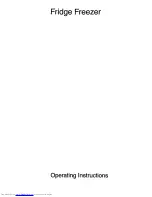
Consumer S
up
por
t
Tr
oubleshooting T
ips
Operating Instructions
Safety Instructions
Installation Instructions
16
Cleaning the Outside
The dispenser drip area,
beneath the grille,
should be wiped dry. Water left in this area
may leave deposits. Remove the deposits
by adding undiluted vinegar to the well. Soak
until the deposits disappear or become loose
enough to rinse away.
The dispenser cradle
. Before cleaning,
lock the dispenser by pressing and holding
the
LOCK
or
LOCK CONTROLS
pad for
3 seconds. Clean with warm water and
baking soda solution—about a tablespoon
(15 ml) of baking soda to a quart (1 liter)
of water. Rinse thoroughly and wipe dry.
The door handles and trim.
Clean with
a cloth dampened with soapy water.
Dry with a soft cloth.
The stainless steel panels and door handles
(on some models) can be cleaned with
a commercially available stainless steel
cleaner. A spray-on stainless steel cleaner
works best.
Do not use appliance wax or polish
on the stainless steel.
Keep the outside clean.
Wipe with a
clean cloth lightly dampened with kitchen
appliance wax or mild liquid dish detergent.
Dry and polish with a clean, soft cloth.
Do not wipe the refrigerator with a soiled
dish cloth or wet towel. These may leave
a residue that can erode the paint. Do not
use scouring pads, powdered cleaners,
bleach or cleaners containing bleach
because these products can scratch
and weaken the paint finish.
Cleaning the Inside
To help prevent odors,
leave an open box
of baking soda in the fresh food and freezer
compartments.
Unplug the refrigerator before cleaning.
If this is not practical, wring excess moisture
out of sponge or cloth when cleaning around
switches, lights or controls.
Use warm water and baking soda solution—
about a tablespoon (15 ml) of baking soda to
a quart (1 liter) of water. This both cleans and
neutralizes odors. Rinse and wipe dry.
Use of any cleaning solution other than
that which is recommended, especially
those that contain petroleum distillates,
can crack or damage the interior of
the refrigerator.
Avoid cleaning cold glass shelves
with hot water because the extreme
temperature difference may cause them
to break. Handle glass shelves carefully.
Bumping tempered glass can cause it
to shatter.
Do not wash any plastic refrigerator parts
in the dishwasher.
The chill/thaw tray is dishwasher safe.
Dispenser drip area.
Care and cleaning of the refrigerator.
About the ice and water dispenser.
(on some models)
Important Facts About Your Dispenser
Do not add ice from trays or bags to
the storage drawer. It may not crush or
dispense well.
Avoid overfilling glass with ice and use
of narrow glasses. Backed-up ice can
jam the chute or cause the door in the
chute to freeze shut. If ice is blocking
the chute, poke it through with a
wooden spoon.
Beverages and foods should not be
quick-chilled in the ice storage drawer.
Cans, bottles or food packages in the
storage drawer may cause the
icemaker or auger to jam.
To keep dispensed ice from missing
the glass, put the glass close to, but
not touching, the dispenser opening.
Some crushed ice may be dispensed
even though you selected
CUBED
.
This happens occasionally when a few
cubes accidentally get directed to
the crusher.
After crushed ice is dispensed, some
water may drip from the chute.
Sometimes a small mound of snow
will form on the door in the ice chute.
This condition is normal and usually
occurs when you have dispensed
crushed ice repeatedly. The snow
will eventually evaporate.
Содержание 200D8074P050
Страница 86: ...Soutien au consommateur Conseils de dépannage Fonctionnement Mesures de sécurité Installation 86 Notes ...
Страница 129: ...Servicio al consumidor Solucionar problemas Operación Seguridad Instalación 129 Notas GEAppliances com ...
Страница 130: ...130 Notas Solucionar problemas Servicio al consumidor Operación Seguridad Instalación ...
















































